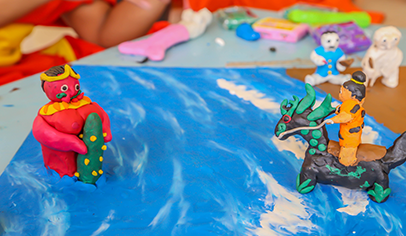How Teachers Use Play-Doh for Middle School and Beyond

kaman123/123rf

When you think of Play-Doh modeling compound, you probably think of arts and crafts projects and the development of fine motor skills. Mostly, you probably associate it with young students. Did you know there are so many Play-Doh learning opportunities for older students? We asked teachers just like you to share their favorite lesson plans for middle school and beyond involving Play-Doh modeling compound. Here are our top 10 picks!
- “I am an ELA teacher for sixth grade. My students love to play with Play-Doh. We will sometimes have setting or plot wars. This is where the students will face off in table groups, using Play-Doh to create the setting or plot of a story. It can also be used to show conflict as well. The texture seems to calm students and brings them together.” Julie R, Conroe, TX
- “Every year my 6th graders read the book “My Side of the Mountain”. In the book, Sam uses clay to make pots for his water and jelly that he makes. My students use Play-Doh to make their own pots like Sam does in the book.” Michelle S, Piper City, IL
- “My 8th graders are currently creating a planet each of them could come from, as we read The Little Prince.” Jennifer D, Providence, RI
- “I am an 8th grade English teacher, and I have students that read at a variety of different levels. We tend to read some “on grade” text and sometimes it’s challenging. I like to use Play-Doh as a kinesthetic way of learning to help students recall important parts of a story. They get in groups and use the Play-Doh to recall what has been read and illustrate what inferences they are making. Most recently we did this with a passage about the sinking of The Titanic. Students made passengers, boats, the Titanic, and the iceberg and were explaining what had happened to one another.” Nicole M, Kokomo, IN
- “I teach Algebra 1 to 8th and 9th grade students. One of my standards is to teach dilations of quadratic functions. This was very confusing to some of my students since a horizonal compression and a vertical stretch visually are similar. Likewise, a horizontal stretch and a vertical compression visually are similar. I use Play-Doh to demonstrate what happens when I stretch the Play-Doh in the vertical direction or compress the Play-Doh in the vertical direction. This allows them to see what happens (narrower vs wider).” Megan D, Fredericksburg, TX
-
“When studying Ocean life, our students created coral reefs by using Play-Doh for the ocean floor, rolling Play-Doh strips and twisting them around pipe cleaners for coral and using shape cutters to create shells and fish living in their reef.” Jenny B, Milford, CT
- “When I taught middle school science, I used Play-Doh when modeling molecules. We created atoms with Play-Doh and bonds with toothpicks.” Chelsie W, Silverdale, WA
- “I use Play-Doh modeling compound in my human development class. We use Play-Doh to create models of the human body and body parts. One of the best lessons to use this for is reproductive parts and the stages of development when a mother is still pregnant.” Vicki D, Huron, SD
- “We have used Play-Doh modeling compound to create model tires for a Mars Rover in a local STEM competition. Students needed to create a model of their tire design and we decided to use modeling compound to create several prototypes.” Carissa S, Pataskala, OH
- “My students use Play-Doh to create controllers for games on their computers using Makey Makey Invention kits. Play-Doh is a great conductor of electricity and easy to mold into colorful controls.” Elizabeth D, Harleysville, PA
If you’re looking for more, you can find ideas for every grade level here!



